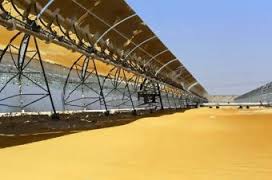The world’s largest concentrating solar power (CSP) plant was launched today. As regular CleanTechnica readers will remember, we’ve covered this 100 MW CSP Plant — Shams 1 — a few times, and Marika Krakowiak and I even got to visit and tour the power plant in January.
CleanTechnica Director Zachary Shahan (me) at the Shams 1 CSP power plant in Abu Dhabi. Photo Credit: Marika Krakowiak / CleanTechnica
In the announcement today, Masdar representatives point out that Shams 1 “will power thousands of homes in the United Arab Emirates and displace approximately 175,000 tons of CO₂ per year.”
The project cost $600 million and took approximately three years to construct.
The power plant is operated by Shams Power Company (which also designed and developed the project), and it is owned by Masdar (60% ownership), Abengoa Solar (20% ownership), and Total (20% ownership).
Shams 1 is a beast of a project that is hard to capture in words or even pictures. To try to put it into perspective, though, the Masdar team writes that the power plant covers 2.5 km², which is equal to about 285 football fields, and that it can generate enough electricity to power 20,000 homes in the UAE.
As I wrote in January: “768 parabolic trough collectors track the sun from sunrise to sunset and use parabolic mirrors to focus the energy of the sun on a central tube containing oil. The concentrated heat is then passed through the system until it is used to boil water and produce steam, which drives a conventional turbine that generates electricity. Additionally, a middle step is the use of natural gas to ‘superheat’ the water. Project managers informed us that this accounts for about 20% of the heat.” By the way, 258,000 mirrors are mounted onto those 768 parabolic trough collectors.
One thing I was not previously aware of is that, with this addition, “Masdar’s renewable energy portfolio accounts for almost 68 percent of the Gulf’s renewable energy capacity and nearly 10 percent of the world’s installed CSP capacity.”
And Santiago Seage, CEO of Abengoa Solar, adds one more interesting fact I wasn’t aware of: “The Middle East holds nearly half of the world’s renewable energy potential.”
GTM Research projects that the Middle East and North Africa (MENA) region will 3.5 gigawatts (GW) of solar power capacity by 2015. For a fairly thorough discussion as to why this transformation is taking place in the oil-rich Middle East, check out my piece about Masdar as a whole.
Shams Power Company Process Engineer Abdulaziz Al Obaidli and Shams Power Company General Manager Yousif Al Ali each told me (in separate interviews) that Abu Dhabi was likely to get most of its renewable energy from solar PV, not CSP, by 2020 (Abu Dhabi has a 7% by 2020 renewable energy target). While power plants like Shams 1 are more flexible — electricity can be generated whenever desired — solar PV is considerably cheaper, and that is unlikely to change any time soon. Solar PV projects are also quicker to build and can be implemented in more locations (in particular, they work well close to or even on commercial and residential buildings — where electricity is consumed).
Kudos to Masdar and Shams Power Company for this notable feat. I look forward to hearing about (and possibly seeing) Masdar’s next big project.
This article was first published at Cleantechnica. Reproduced with permission.











